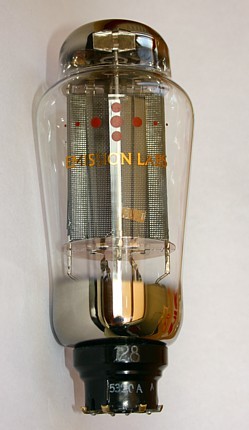AZ4 Mesh Data Sheet
Description
 |
historically, AZ4 was parts of a new generation rectifier tubes, following up the famous RGN Series of Telefunken, intended for applications the AZ1 by Philips, could not do. AZ4 is in between 274B and 5U4G. The smaller AZ1 was the mostly used rectifier tube in Europe, and electrical identical to RGN1064. The more powerful AZ4 is on par with stronger tubes like RGN2004. AZ4 is an ideal candidate for HiFi applications. It can easily supply a stereo amplifier using a pair of AD1 or 2A3, as done for instance in the Yamamoto A06-03 amplifier. The base of this tube is an original old Bakelite base, that we remove from NOS tubes. |
Guarantee program for first owner.
The first owner can register the tube within 4 weeks after receival, at the Emission Labs ® website, to participate in the 5 years guarantee program, which is additional to the legal obligations of the seller.
Register here for the 5years guarantee
Features
- Soft rubber suspended tube base
- Hard metal Construction (Note1)
- Extra large getters
- Hand blown Glass bulb
- These tubes are shipped in a high quality single box
- Tube printing with real gold (metal), red color is glass burned into the glass
- For AZ4, we apply original bake lite NOS Tube base from 1950
- YAMAMOTO tube sockets or NOS Sockets recommended. New made Chinese sockets are troublesome and not recommended.
Filament Ratings AZ4 |
|
| Filament Voltage | |
| Tolerance on filament voltage | |
| Filament Current | |
Maximum ratings
|
|
AC input voltage |
300Volts |
DC output current |
200 mA |
| Minimum Copper Resistance of transformer winding Raa. Add two normal resistors in series, if copper resistance is below 2x 60 Ohms. | 2x 60 Ohms |
| Maximum First capacitor, connected to Anodes | |
AZ4 Mechanical Data |
|
|
Size of Glass Bulb |
Tube weight: |
|
Shipped weight for a single boxed tube: |
|
Previous Type |
Later Type |
Max Transformer AC |
Max Capacitor |
Heater Current |
Max DC output |
RGN1064 |
AZ1 |
2x 300V |
60uF |
1.1A |
100mA |
RGN1054 |
AZ3 |
2x 350V |
12uF |
2A |
120mA |
RGN2004 |
AZ4 |
2x 300V
|
60uF |
2.3A |
200mA |
RGN4004 |
AZ50 |
2x 500V |
64uF |
3A |
250mA |
SOME DESIGN NOTES FOR POWER SUPPLIES
Design note-1
Design note-2
Note 1) Good care should be taken when making the design of any DHT rectifier. It must be prevented to have strong current peaks, through the first capacitor, because consequently this flows through the tube anode, and transformer windings as well. The transformer will produce mechanical hum by this, most specially if windings symmetry fails. Also the tube will suffer. For this reason, the first capacitor (C1) should never be larger than stated in this data sheet. The mechanical transformer hum, and also tube current peaks are greatly reduced by smaller capacitor values, and use higher choke values instead. Although higher capacitor values come at lower cost, using lower capacitors and higher chokes values instead, is always more satisfactory in the end. The result will be: Lower transformer hum, less electrical field radiation into the pre-amp, and more lifetime from the rectifier tube. This is why we recommend using largest chokes. From Lundahl, high value chokes are achievable at the same price as HiFi capacitors, like from a Mundorf or Black gate. So we have to go back to the roots, and use high quality, large value chokes, like in the old days of radio design. For best ripple suppression, increase the choke to any value you need, or even use an C-L-C-L-C circuit, as also advised in the historical RCA data sheet.
Note 2) As a rule of thumb, high voltage power supplies are work best with large size chokes, specially at high output current, whereas low voltage power supplies are more conveniently build with larger capacitors.
Note 3) Windings symmetry is needed with HV transformers to prevent hum. A HV winding with Cathode Tap, requires FOUR separated HV windings inside the transformer, which are arranged for the end user as TWO windings which are in series. It is remarkable to see, this is widely unknown today by many transformer manufacturers. Also this is more expensive. So often, they build tube rectifier windings only from two internal windings, and not FOUR windings as needed for tube rectifiers. However we have a tube data sheet here, no transformer construction manual, so we can not explain this in full detail.
